Tourism pressures: Five places tackling too many visitors
 Getty Images
Getty ImagesIn recent weeks, authorities in Thailand and the Philippines have called time on tourism in two of their most popular tourist destinations.
First, Thai officials said Maya Bay needed an enforced break from the daytrippers who have flocked there since it was featured in 2000 film The Beach.
Then Philippine President Rodrigo Duterte announced that Boracay Island will also be closing for a few months, having, in his words, become an overcrowded "cesspool".
And these are not the only ones. Various European cities, including Venice and Dubrovnik, have also complained of being swamped by visitors, as has the Isle of Skye in Scotland.
In 2017, Barcelona launched a crackdown on unlicensed accommodation rented via the AirBnB network, saying it was pushing up rental costs for locals.
Other places have hiked up fees for visitors to protect their assets. Rwanda now charges $1,500 (£1,000) a day for a gorilla-watching permit.
Here we take a look at five destinations around the world figuring out ways of dealing with their own popularity.
1. Thailand: Maya Bay finally gets a rest
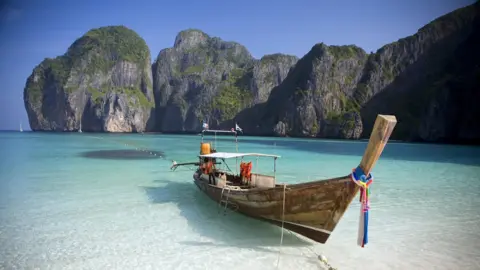 Getty Images
Getty ImagesIn March, Thai authorities announced they were closing the country's famed Maya Bay to allow it a brief respite. The secluded cove - with translucent waters, white sands and limestone cliffs - shot to fame as the picturesque setting for The Beach, starring Leonardo DiCaprio. Since then between 4,000 and 5,000 visitors have been turning up on its shores daily.
Experts have said 77% of Maya Bay's coral is at serious risk, mainly from damage by boat anchors. The planned four-month break this year - from June to September - cannot fix that.
So, is it too late to save Maya Bay?
Bangkok-based marine scientist Thon Thamrongnawasawat does not think so.
"If we thought it was too late, we would do nothing," he told the BBC. "We closed one island, called Koh Yoong, three years ago, and the corals there are growing very well. We will use the same practice in Maya Bay and try to transplant some coral as well."
Thailand closed dozens of dive sites to tourists in 2011. Koh Yoong, in the Phi Phi island chain and Koh Tachai, in the Similan Islands National Park, have also been off-limits to visitors since mid-2016.
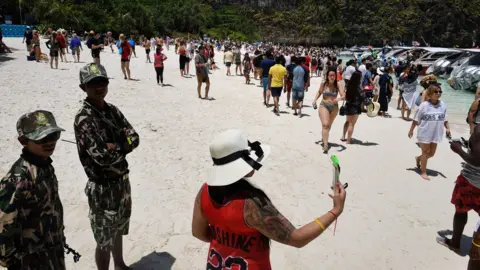 Getty Images
Getty ImagesElizabeth Becker, author of Overbooked: The Exploding Business of Travel and Tourism, said: "I think it makes sense to close islands. However, there are huge economic pressures on Thailand, especially during these difficult political times. Tourism has been key to Thailand's economic development so Thai businesses and officials are afraid any curtailment of tourism would imperil the Thai economy."
Mr Thamrongnawasawat thinks this is why it has taken so long to take action at Maya Bay. "If you are in a country that earns more than 22% of GDP from tourism, you will understand how hard this was. Most people did not think this could really happen."
When Maya Beach reopens, it will have a new daily limit of 2,000 tourists a day and boats will no longer be allowed to cross the shallow reef. It will also close again for four months next year.
However, Worapoj Limlim, the head of the area's national park, told the Phuket News that he was not sure how he would enforce the new ban, and he might need back-up to add to the small team that already patrols the shores.
2. Italy: Cinque Terre tries technology
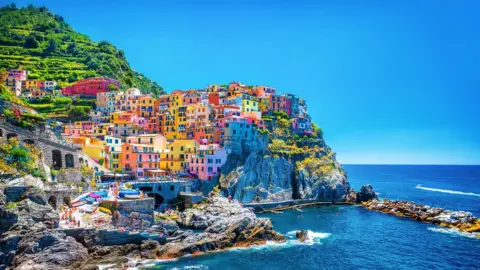 Getty Images
Getty ImagesTourists cannot get enough of the five brightly painted cliffside towns in northern Italy known as Cinque Terre. The area, which has about 5,000 residents, became a national park in 1999 and now receives more than two million tourists per year.
People come to hike the scenic paths that link the towns and the terrace vineyards. Over the years, the walkways have fallen into disrepair from erosion and overuse.
The popular route between the towns of Riomaggiore and Manarola has been closed since September 2012, after a group of Australian tourists was injured in a landslide. Another hiker on a different path was hurt during 2018's Easter weekend, according to La Nazione news site.
There has been plenty of talk about imposing a limit on the number of visitors, but that has not yet happened.
Lately, park authorities have been trialling an app which tourists can download to see the number of people on the routes in real time. When a red warning sign shows, a path is overcrowded and visitors can then make up their minds if they want to join the throngs. In the future, they may trial virtual waiting lists.
Visitors are also encouraged to buy a Cinque Terre Card, which allows access to trails and public transport. It is not obligatory but the proceeds go towards trail repairs, among other things.
Richard Hammond, who runs GreenTraveller.com, told the BBC now was the best time for change across the world.
"People are becoming more aware of how they are travelling and how they are living," he said.
"For example, there is suddenly more widespread awareness of plastic usage - only in the last year - and this is spilling over into other areas of people's lives, making it more palatable to make changes. The way is open for governments and local authorities to act because they won't have the backlash that they had in the past."
3. Peru: Machu Picchu turns to time slots
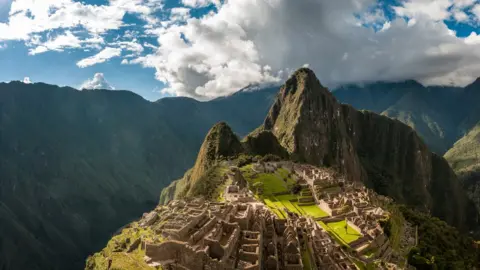 Getty Images
Getty ImagesPeru's ancient Inca citadel of Machu Picchu is on the must-see list for many keen travellers.
Its famous Inca Trail allows visitors to hike their way there - through Andean landscapes and cloud forests - which many say is an even more fulfilling experience.
However, too many people and too many informal operators were leading to damaged routes, rubbish pile-ups and out-of-control campsites.
In 2005, the Peruvian government placed a limit on the number of people allowed to hike the trail per season. It is also closed every February for cleaning and maintenance.
Tourists have adapted by booking ahead, and tour companies have to abide by regulations to keep their allocated permits.
However, visitors still flood through Machu Picchu itself, which, for the vast majority of people, is accessed by road.
Last year, the authorities brought in new system, which involves buying a ticket for either the morning or the afternoon, in a bid to control the numbers.
However, one local environmentalist told the BBC they feared this was just a quick fix. The site is known to be surpassing Unesco's recommended cap of a maximum of 2,500 visitors per day.
4. South Korea: Jeju Island
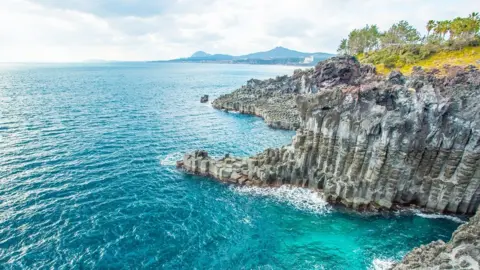 Shutterstock
ShutterstockCan you guess the busiest flight route in the world?
Last year, it was between South Korea's capital, Seoul, and Jeju island, a tourist destination about 90km off the mainland. People come to take in the volcanic landscapes, picturesque waterfalls - and an erotic amusement park, which is popular with honeymooners.
In 2017, almost 65,000 flights went between these two airports, working out at almost 180 per day. Annually, about 15 million tourists visit the island, according to the South China Morning Post. That is a lot of people for an area under 2,000 sq km (700 sq miles).
Kang Won-bo, director of a local protest group, told the Korea Times: "[Jeju's] once-pristine environment has been seriously damaged after it became popular with outsiders. There is more trash and traffic jams."
Speaking to the BBC, Catherine Germier-Hamel, a sustainable tourism consultant based in Seoul, said: "The island is also receiving lots of cruise visitors, who just stay a few hours and do not really contribute to the local economy."
Ms Germier-Hamel said that across the world, people tended to measure tourism success purely in terms of the number of arrivals, and this needed to change.
And how about the carbon footprint from all those flights?
It does not look like it will be addressed anytime soon: the South Korean government is considering another airport in southern Jeju, which it thinks could triple the annual number of tourists to 45 million by 2035.
Jeju Island is also particularly popular with Chinese tourists. The growth of the Chinese travel market is viewed as causing major new strains across the region.
However, in the case of Jeju Island, things took an odd turn last year when China banned its travel agencies from selling package tours to South Korea in protest at Seoul's decision to utilise a US-made missile defence system, which Beijing saw as a threat to its security. That ban has now been lifted.
5. Colombia: Caño Cristales starts with a rulebook
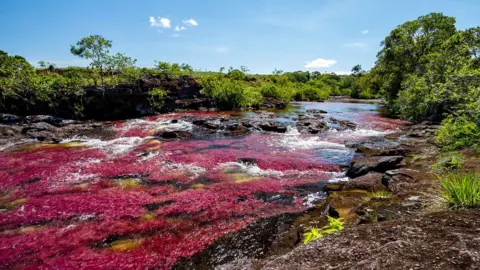 Alamy
AlamyColombia's Caño Cristales is a surreal site - a river that appears to run a whole spectrum of colours. Thanks to aquatic plants and tricks of the light, it ripples red, pink, lime green and yellow. Locals in the central Meta province call it the liquid rainbow.
This was formerly the heart of territory occupied by Farc guerrillas, meaning tourism - both foreign and domestic - was pretty much non-existent.
But in recent years - especially after the 2016 peace deal was signed - visitors have started to venture into the country's inner depths and see this much-photographed wonder for themselves, using the tiny town of Macarena as their base.
Caño Cristales does not see anywhere near the same amount of visitors as some of the other places on this list (about 16,000 in 2016), but does have a tough task of balancing an unprecedented influx with an extremely delicate ecosystem.
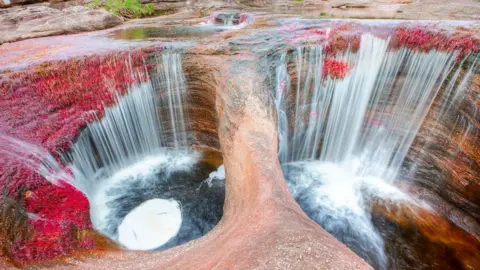 Alamy
AlamyThere are concerns that more people in the area might risk an increase in pollution and damage the precious aquatic plants.
Unusually for an emerging destination, it has started off on the right foot by instigating a number of rules: no plastic bottles, no sunscreen or insect repellent in the water, no swimming in certain areas, no cigarettes, no feeding the fish. On arrival, visitors attend a briefing to ensure all of this is entirely clear.
Henry Quevedo, president of the Caño Cristales tourist board, said tourism here was very much a local project, with hundreds of families playing a role acting as tour guides and hosts. They are now undergoing training and learning other languages.
However, there are still environmental concerns over a possible increase in flights (visitors typically arrive from Bogotá, 170 miles to the north) and SUVs, which drive people from the town of Macarena to the river itself.
In December, access was restricted to give the river a break. Faber Ramos, co-ordinator of the ecotourism program, told news site Semana Sostenible: "Human presence can harm the plants' reproduction processes. That's why we decided to implement the restriction."

You may also like:

All photographs copyright of Alamy, Getty Images and Shutterstock
